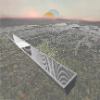Strange Towns

On May 27, 1962, the coal seam that runs through the town of Centralia, Pennsylvania, was ignited by the deliberate burning of trash at the Centralia landfill, located in the pit of a former strip mine. After two decades of unsuccessful attempts to put out the fire and remediate the site, the town was abandoned—bought out by the federal government, and its buildings subsequently demolished— leaving behind traces of an eroding street grid and an ever-dwindling number of residents that refused relocation. The fire— 1,000 degrees Fahrenheit at its core and advancing at a rate of 50-75 feet per year— still burns today and could continue to do so for another 250 years.
Gallery
Students
Samendy Brice
Tierra Bush (Centralia, PA)
Tom Foederer (Green Bank, WV)
Sylvester Mallardi
Rumaldo Genao (Picher, OK)
Faculty
Term
ARC 606
Spring 2019
Program
MArch
On May 27, 1962, the coal seam that runs through the town of Centralia, Pennsylvania, was ignited by the deliberate burning of trash at the Centralia landfill, located in the pit of a former strip mine. After two decades of unsuccessful attempts to put out the fire and remediate the site, the town was abandoned—bought out by the federal government, and its buildings subsequently demolished— leaving behind traces of an eroding street grid and an ever-dwindling number of residents that refused relocation. The fire— 1,000 degrees Fahrenheit at its core and advancing at a rate of 50-75 feet per year— still burns today and could continue to do so for another 250 years.
For this studio, students identified and researched ten American towns that pose “strange” situations for architecture and urbanism. The outcome: a series of speculative design proposals that—by pairing the towns—address the particular opportunity posed in one by borrowing from the curious model offered by the other. Final projects focused on imagining alternative futures for five towns (California City, CA; Green Bank, WV; Picher, OK; Madero, TX; and Centralia, PA), promoting strange new ideas of inhabitation, structure, organization, and program.
Centralia, PA
Centralia is a strange town. But what if Centralia was reconceived not as a city for the living, but for the dead? Where the infrastructure for burial was designed to extinguish the fire?
Areas close to Centralia, like Philadelphia, Washington, DC, and New York City, are experiencing a shortage of burial space within their cemeteries. In Centralia, the dead will outnumber the living, and become the new burial center of the eastern region of the US. Brice and Bush propose to transform Centralia into the City of Repose by building a trench structure, which would double as a cemetery, that will extinguish the fire and open up opportunities for Centralia to redevelop. Influenced by one of the former attempts to put out Centralia’s underground fire, four trenches would be placed strategically in the predicted path of the spreading fire.
The proposed trench would be 9,791 feet long and between 450 and 830-feet deep, providing 2,637,914 chambers for burial. Centralia would become a new hub for burial, serving Columbia County and any areas within a 500-mile radius facing cemetery overcrowding.
Green Bank, WV
Green Bank is a strange town. Despite being home to the world’s largest fully steerable radio telescope, it is a place where modern technology is restricted in service to an exploration of the cosmos. The rural landscape is punctuated by seven large-scale radio telescopes, most notably the 485-foot tall Green Bank Telescope. The telescope has a dish diameter of 328 feet and is in operation 24 hours a day for 362 days of the year.
Situated deep in the heart of Appalachia, the geography of the Green Bank Valley makes the region particularly suitable for practicing radio astronomy, which is why the National Radio Astronomy Organization established the Green Bank Observatory in 1956.
In 1958, the FCC established the National Radio Quiet Zone, a 13,000-square mile region that required all proposed radio transmitters to be coordinated directly with the GBO. The state and federal legislation can be understood as a series of restrictive zones. Within Zones 3 and 4, the GBO actively patrols, measures and documents radio transmissions that are outside of the allowable range.
In Zone 1, any electronic that emits radio frequency is restricted, meaning that no gas-powered cars or wireless electronics are allowed. As the rest of the world becomes increasingly interconnected via technology, the curiosity of Green Bank as a town in radio silence has become all the more compelling.
What if Green Bank adopted a mode of living that both accentuated and maximized the curiosities of the place?
Though Green Bank is optimal for studying radio astronomy, the potential lifestyles that a place technology-free offers are far more extensive. Silent City is conceived in the spirit of the Maharishi University of Management, where an overarching ideology and common belief in a techfree life, centered on the cult object of the Green Bank Telescope, brings together an eclectic cast of people. In this way, Silent City will cater to groups of people ranging from scientists, agriculturists, and artists, to the electromagnetic sensitive, tourists, and those prescribing to the teachings of Vastu Shastra. Rather than deriving a segregated model, all populations live in the same rectangular block, where four different lot sizes afford every person or family a unit of land on which they can explore their own unique interests with autonomy.
The proposed public spaces will draw individuals from across groups throughout the city, thus serving as a melting pot and contributing to the crosspollination of ideas and practices. The potential offerings of each group will then contribute to the self-sustaining nature of the place, and result in a more realized instantiation of the utopian aspirations of Maharishi Vedic City centered on the cult object of the Green Bank Telescope.
Picher, OK
Picher is a strange town. Consumed by a manmade landscape of toxicity, it is virtually uninhabitable and is among the largest environmental disasters in US history. Established in the early 1920s as a mining town, the area was the source of 75% of all the lead and zinc produced in both WWI and II. As production increased until 1967, large tailings deposits reaching upwards of 16 stories consumed the town. In 1981 the EPA declared it part of the Tar Creek Superfund Site, located between the Kansas, Oklahoma, and Missouri borders, as it was too toxic to clean up. In 1991, the US Army Corps of Engineers found that 98% of the ground in Picher was severely unstable due to extensive mining. The EPA and the indigenous people of Quapaw began remediation efforts through the excavation of tailings mounds, trucking to Central Mills Repository, placing them in a manmade pond, and then capping, like a landfill.
Defined by disaster, the already severely damaged town saw an EF4 tornado pass through its heart, destroying many of the buildings that remained. In 2009, the closing of the high school and demolition of the remaining commercial structures sealed the town’s fate, leaving Picher the uninhabitable ghost town it is today.
What if Picher was reimagined as a radical answer to extreme environmental damage, through massive infrastructural design and landscape transformation?
Last Resort is an urban intervention to the toxic landscape of Picher that brings together what was, is, and will be through a massive, yet light touch to the ground. The proposal takes cues from Picher’s industrial history and current remediation efforts to inform the design of a mechanized infrastructural system that will remediate the Tar Creek Superfund Site.
This one interconnected infrastructural track, spanning roughly 25 miles, negotiates a zone of maximum preservation for Picher on the interior while serving as a guide for the machine that will remediate the exterior, leaving a new urban trace in the landscape.
This infrastructural track acts as a mode of interaction between large scale remediation efforts and those people who are interested in and serious about the environment, remediation, and ecotourism, by providing a platform on which a single building rests. This fully enclosed resort unites visitors and EPA workers through a variety of educational programs.



